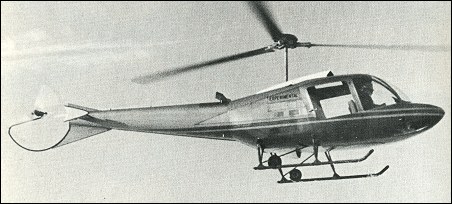
| Spitfire Mk.II 2003 |  |
 |

| Spitfire Mk.II 2003 |  |
 |
|
The Spitfire Helicopter Company became associated with the Enstrom Helicopter Corporation in January 1975 when it began to develop, under the designation Spitfire Mk I, a turbine-engined light helicopter based on the Enstrom F-28A. Apart from its turbine engine, the Spitfire Mk I also introduced a conventional reduction-gear transmission instead of Enstrom's arrangement of multiple belts, thus making a saving in structure weight of 91kg and economizing on fuselage space which could then be used for auxiliary fuel or extra freight. Prototype construction began in January 1976, and a number of pre-production helicopters were begun in February 1977. The Spitfire Mk II is basically an improved version of the Mk I, with more power and a slight increase in size to allow the carriage of three passengers rather than two. Although the rating of the Allison 250-C20B remains substantially unaltered, its take-off power has been increased slightly to cater for the greater take-off weight of the Mk II (1134kg compared with 1043kg). The empty weight of the Mk II at 601kg is only 34kg greater than the Mk I’s 567kg. The fuselage length of the Mk II has been increased slightly, with overall length rising from 8.96m to 9.3m. Accommodation in the Mk I is provided for the pilot and two passengers seated side-by-side on a bench seat, but in the Mk II seating is for the pilot and three passengers side-by-side on a wider bench seat. Baggage space on the Mk II consists of a 0.57m3 compartment aft of the cabin, with loading doors on each side of the fuselage. Despite the Mk II's greater weights, it appears to be marginally superior to the Mk I in performance: cruising speed is up 16km/h, while rate of climb and service ceiling remain unaltered. The first Spitfire Mk II flew in the second half of 1978, and will probably enter production in 1981. The company's future plans include the Mk III, a four-seat helicopter with stub wings to help offload the rotor in forward flight, thus enhancing performance; and the Mk IV, derived from the Mk III but with larger wings and an auxiliary propulsion engine in the rear of the fuselage, plus the unusual feature of the torque-control tail rotor replaced by ducted fans at each wingtip. Bill Gunston "The Illustrated Encyclopedia of Commercial Aircraft", 1980  Spitfire Helicopters of Media, Pennsylvania was founded by John J. Fetsko and devel-oped a three-seat helicopter based on the Enstrom powered by a 420shp Allison 250-C20B turboshaft engine. The first prototype (N4890) was converted from an existing F.28A airframe, and a second machine designated Spitfire Mark II had a stretched cabin section and upgraded engine. It was intended to build the Spitfire Mark II and the further develped Mark III and Mark IV in a new facility in Malaga, Spain, but this proposal was not pursued. R.Simpson "Airlife's Helicopter and Rotorcraft", 1998
The first project undertaken by the company was the development of a helicopter based on the Enstrom F.28A. In 1978 the firm signed an agreement with the Polish helicopter manufacturer, WSK, for the marketing of the twin-turbine WSK-PZL Mi-2, and in 1982 it entered into collaboration with Sodian in order to produce Spitfire helicopters in Spain. The Spitfire Helicopter Company began developing a light turbine- powered helicopter in the mid 1970s: the Spitfire Mk.I, based on conversions from the Enstrom F.28A. Apart from the use of a turbine, the Spitfire has a thoroughly conventional transmission system which saves a considerable amount of structural weight — about 90kg — and also economizes on cabin space. On the subsequent Spitfire Mk.II variant, capacity has been increased from three to four seats and a more powerful 315kW Allison 250-C20B turbine adopted. Despite the increase in weight, the overall performance of the second version is much better. Further projected developments of the formula chosen by Spitfire — who have also been responsible for marketing Polish helicopters by Pezetel in the West since August 1978 — include the turbine-engined Mk.IIIA and the twin-turbine Mk.lV four-five seat compound. G.Apostolo "The Illustrated Encyclopedia of Helicopters", 1984
|